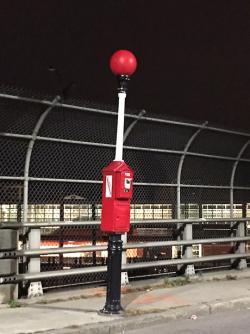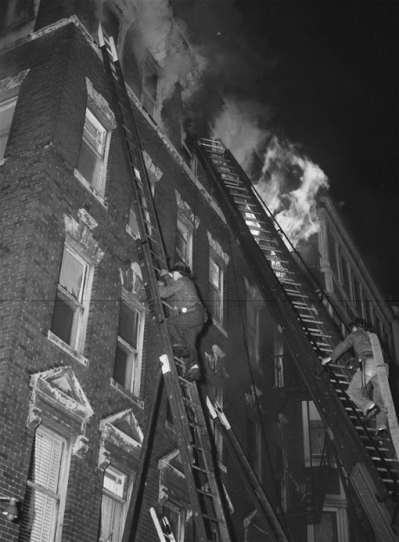October 6, 2016
 Old Reliable Box 186: a typical street fire alarm box, part of Boston’s security blanket, providing uninterrupted operation since 1852 (first fire alarm system in the world). Today, all big cities in the northeast maintain fire boxes. Roberta Hobin photo“What are those things, anyway?”
Old Reliable Box 186: a typical street fire alarm box, part of Boston’s security blanket, providing uninterrupted operation since 1852 (first fire alarm system in the world). Today, all big cities in the northeast maintain fire boxes. Roberta Hobin photo“What are those things, anyway?”
That’s what a few local high school students asked me when I showed them a photograph of a red box and a red lamp affixed to a pole set into a sidewalk. They had seen them around the neighborhood, but had no idea of why they were there and what they were for. I explained that each box is a direct link to Boston Fire Department headquarters, and that by pulling the lever in the box, you send a call for help.
The students shrugged. They all know that calling for help is easy, as long as you have a cell phone. They are too young to remember a time when the phone was not ubiquitous, when, in an emergency, the fire department could seem like it was a million miles away.
The 1960s and ’70s were a time when the fire boxes in Dorchester were especially active. Mike Foley, a retired lieutenant in the BFD, was stationed at firehouses in Dorchester and Roxbury from 1969 to 1983, a period during which three-deckers were flaring up like roman candles. He has written a book about his experiences over those 15 years and titled it “Busy as Hell.”
Mike’s words give a sense of what it was like to be a firefighter working in a busy engine company before the advent of high-tech fire security measures. It seems as if those old-timers could have put out a fire with a damp sponge. They went to work in dungarees, work shoes, and a helmet. In 1977, air masks became mandatory, but before that, the average firefighter usually tucked his chin into the collar of his jacket and rushed forward. A few hardy fellows had reputations as “smoke-eaters,” for their ability to withstand the worst.
Engine companies competed between themselves, and with ladder companies, too. The different companies took pride in delivering “first water.” The big hoses squirted 200–250 gallons of water per minute with 500 gallons in the truck. When they said, “Give ‘em the tank,” minutes were gained against a spreading blaze while more lines were hooked up to the hydrant. Three men were needed on the nozzle of a 2.5-inch hose, unless it was looped around a building or a parked car to help minimize the reaction force.
 A 1970s fire scene: All in a day's work. The jake on the right will move the 2 1/2" line through the window dressed as you see him here - no fire coat, boots or gloves, just his helmet and a Dungaree jacket. Bill Noonan photo/FireFotos.com
A 1970s fire scene: All in a day's work. The jake on the right will move the 2 1/2" line through the window dressed as you see him here - no fire coat, boots or gloves, just his helmet and a Dungaree jacket. Bill Noonan photo/FireFotos.com
The BFD believed in the interior attack – the first line went through the front door. Most importantly, the building had to be ventilated. Boston’s firefighters were famously known for throwing ladders and getting on top of a building to make an opening for the heat and smoke to escape, which helped to minimize backdraft flash. With this accomplished, companies could go deeper to search for the heat source, crawling on the floor and staying low to find air to breathe and feeling doors for heat before opening.
Behind a door, the fire could be thriving and feeding on itself; heat could build up and suddenly radiate back from the ceiling, flashing over an entire room at 1,000 degrees or more. The firefighters knew that if their ears started to burn, the heat at the ceiling was dropping down, and it was time to get out.
There were more fires then because so many old houses were made of wood and were full of old and overloaded wiring, which led to electrical fires. Also, many houses had improvised heating systems that were dangerous. For instance, kerosene space heaters might have been responsible for the so-called “Bellflower Street Conflagration” in 1964, a five-alarm fire that involved 30 three-deckers across Bellflower, Dorset, Howell, and Boston streets. The fire started on the rear porch of 26 Bellflower. It’s possible that years of spillage from a kerosene storage tank kept there had soaked into the floor boards, which inadvertently ignited and spawned a firestorm.
Smokers presented another danger. Smoking in bed, in particular, was a problem. Also, the cliché of the drunken smoker passed out and self-immolating on an armchair not infrequently became a reality. Fires happened because people caused them to happen, usually by accident, but not always. Some were set to exact revenge; some were set for kicks by kids with nothing to do; and some were set by workers, who, being paid more to tear down burnt buildings, put the match to those slated for demolition. Not least of all, fires went hand in hand with civil unrest.
Well before busing came along, Dorchester was splitting apart due to racial segregation. For far too long, certain areas were cut off and politically marginalized, so residents began fighting back against authority in whatever ways they could. Given that, the fire department was targeted because it was misperceived as another arm of the law. In 1967, the BFD improvised Plexiglas shields on fire trucks to protect firefighters racing to put out fires from gunfire and rocks thrown by angry crowds.
White flight and redlining by real estate interests and the banks provided much of the kindling for devastating fires after thousands of foreclosed properties had been left vacant. Boarding services to protect the houses were practically unheard of, so after being abandoned, the buildings were left wide open to become derelict and a haven for intruders of all types, including pyromaniacs. Sometimes, fire companies returned to the same buildings so often that they called them “drill towers.” This is why Mike Foley subtitled his book “The War Years.”
The gasoline crisis of the mid-1970’s has been called another factor in the increased incidence of fires. Back then, people were ditching their cars because they could not afford to buy the gas to drive them. Desperate individuals drove to deserted streets to burn their cars (about 6,000 car fires per year then; under 500 these days). There were many other factors that contributed to the large spike in fires in the city 40 years ago, but the most destructive of all was the burning-for-profit motive. Arson was serious issue. The people who torched their cars were picking up on an illegal practice that had become a local institution.
In the mid-‘70s, the market value for an occupied three-decker in good shape was $8,000 to $12,000, but in some places they were worth about $1,000. Heedless of the mayhem that they were unleashing, a number of unscrupulous absentee landlords set fires to collect insurance on their properties. They got away with it for a long time because it’s tough to prove arson. In the late ‘70’s, the BFD began feeding data into a computer and patterns emerged revealing serial complex schemes of insurance fraud organized by individuals who really knew what they were doing.
People went to jail for this arson, but not before inflicting a lot of damage. Old aerial photographs of Dorchester and Roxbury show gaping holes where buildings once stood. There are instances of entire streets vanishing, with neighbors moving away one by one as the firebugs descended. Some of these lots became urban gardens and some were redeveloped; too many remained barren for decades. They scarred the landscape but we learned not to see them – hardscrabble patches of gray dirt crisscrossed with footpaths used to shortcut the sidewalk. Today, these vacant lots are worth a lot of money.
Since the 1990s, a three-decker, or any other dwelling can’t be built without a sprinkler system. And fire companies are outfitted with better equipment, including thermal cameras that see through smoke.
There are fewer fires now, and more rescue work. Thanks to everything that has been done to improve fire safety, we can go to sleep at night without worrying about the house burning down. Still, I am feeling nostalgic for the old-time firefighter, part daredevil, part acrobat. I doubt that they ever considered themselves as heroes. They were just doing their job.
“Busy as Hell,” by Mike Foley and published by Fire Barn Press, is available at bfdbusyashell.com, “Busy as Hell 2,” now in the works, is set for release next spring.
Topics:


